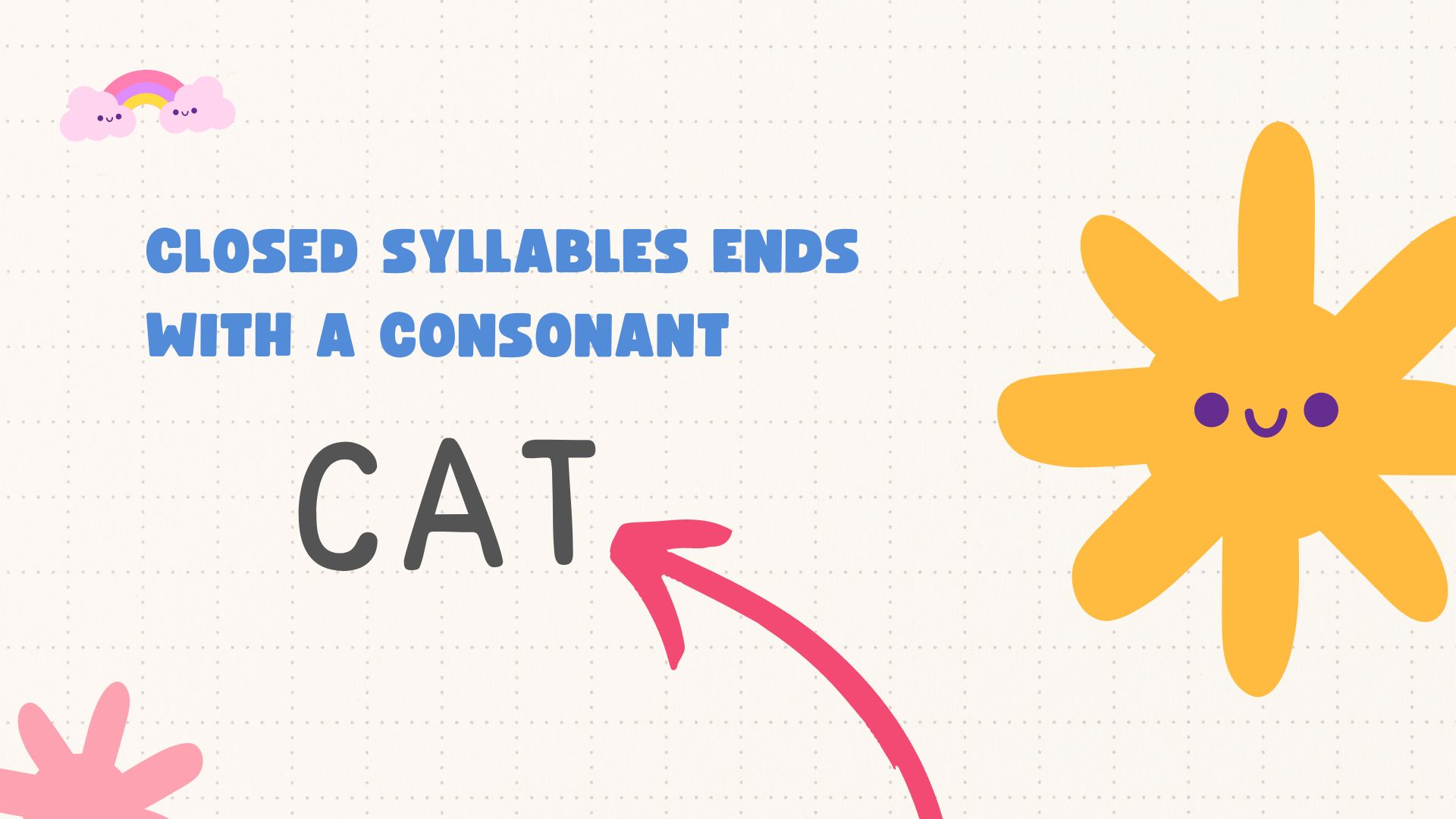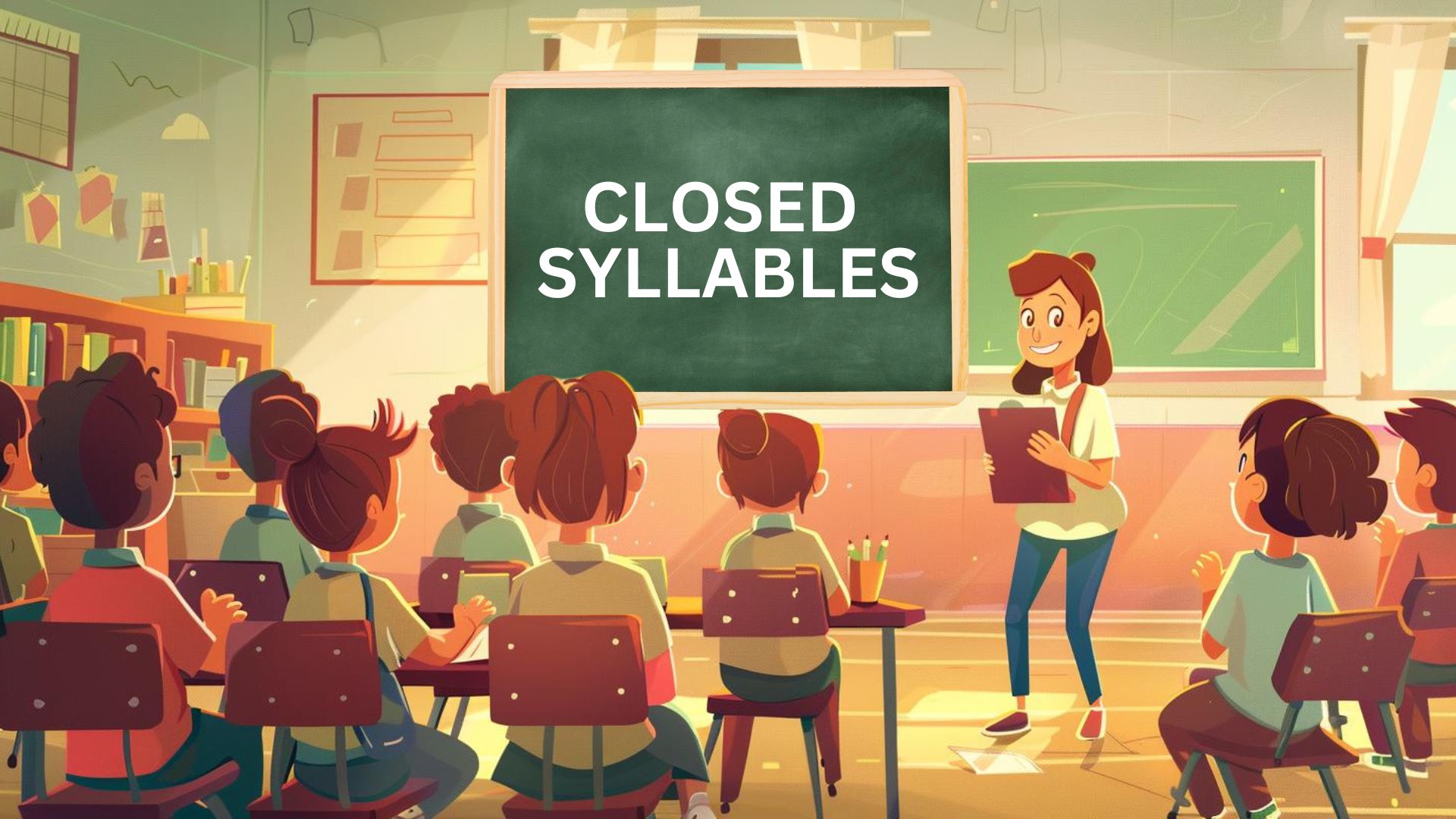Learning to read and spell can be challenging, especially when it comes to understanding the different syllable types in the English language.
Closed syllables, in particular, play a crucial role in building a strong foundation for literacy skills.
In this blog post, we’ll explore practical tips and techniques to help you master closed syllables and improve your reading and spelling abilities.
We’ll begin by explaining what closed syllables are and why they’re important.
Then, we’ll dive into specific strategies you can use to identify, read, and spell closed-syllable words with confidence.
By the end of this post, you’ll better understand how to approach closed syllables and be well on your way to becoming a more proficient reader and speller.
1. Closed Syllables

Phonetics and phonology are essential components of language that help us understand how sounds work together to form words.
In English, mastering these aspects is crucial for developing strong reading and spelling skills.
One of the key concepts in phonetics is the syllable, which is a unit of pronunciation that typically consists of a vowel sound and any accompanying consonant sounds.
Closed syllables are the most common type of syllable in English.
They are characterized by a single vowel followed by one or more consonants, which “close” the syllable.
This structure causes the vowel to produce a shorter, clipped sound. Some examples of closed syllables include words like “cat,” “sit,” and “band.”
Characteristics of Closed Syllables
Understanding the characteristics of closed syllables is essential for developing decoding skills, which involve sounding out words accurately and quickly.
When readers encounter a closed syllable, they can recognize that the vowel sound will be short, helping them pronounce the word correctly.
- Closed syllables are often among the first types taught to children learning to read because of their prevalence and simplicity. By mastering closed syllables, early readers can build a strong foundation for literacy. For example, understanding how the closed syllable structure affects pronunciation in words like “bat” versus “basket” can help students read more fluently.
- Moreover, a strong grasp of closed syllables benefits English as a Second Language (ESL) students. Recognizing closed syllables can help them pronounce words more accurately and improve their reading comprehension as they learn to navigate the complexities of English pronunciation.
- In summary, closed syllables are fundamental building blocks of English pronunciation and literacy. By understanding their structure and role in phonetics, readers can develop better decoding skills, improving reading fluency and comprehension.
2. Phonetic Foundation
Understanding phonetics is crucial for developing strong literacy skills, as accurate pronunciation directly influences reading comprehension and fluency.
In English, how vowels are pronounced in closed syllables is a key aspect of phonetics that students must master.
In closed syllables, the vowel sound is influenced by the consonant(s) that follow it.
This structure leads to short vowel pronunciations, where the vowel sound is clipped and brief.
For example, in words like “cat,” “bed,” and “top,” the vowel is enclosed by consonants, resulting in a short vowel sound.
To help students master short vowel pronunciations, it’s useful to provide a pronunciation guide for each vowel in its closed syllable form:
- “a” as in “cat” or “bat”
- “e” as in “pen” or “bed”
- “i” as in “pin” or “sit”
- “o” as in “top” or “hot”
- “u” as in “cup” or “hut”
Common Mistakes While Learning Closed Syllables
Students often make common mistakes when learning closed syllables.
One error is confusing closed and open syllables, leading to mispronunciation.
For instance, a student might pronounce “cap” as “cape,” incorrectly applying the long vowel sound associated with open syllables.
Another mistake is incorrect decoding, where students misinterpret vowel sounds due to inconsistent application of phonetic rules.
This can lead to errors when decoding multisyllabic words, such as pronouncing “basketball” as “bas-ket-bull” instead of “bas-kit-ball.”
Tips to Overcome These Challenges
To help students overcome these challenges, teachers can employ practical solutions:
- Provide explicit instruction on the difference between short and long vowel sounds, emphasizing the role of syllable structure in determining pronunciation.
- Use visual and auditory aids, such as vowel charts, videos, or word cards, to reinforce vowel pronunciation visually and aurally. This multi-sensory approach can help students internalize the correct sounds.
- Encourage frequent practice through word sorting or decoding exercises that strengthen recognition and proper pronunciation of closed syllables.
By understanding the phonetic foundation of closed syllables and implementing these strategies, students can improve their pronunciation, decoding skills, and overall reading proficiency.
3. Teaching Methodologies
Effective teaching methodologies, such as closed syllables, are crucial in helping students grasp and retain foundational literacy concepts.
By employing proven strategies, educators can ensure students develop a strong understanding of these essential building blocks.
Explicit Instruction
One key approach is explicit instruction, which involves structured, systematic lessons that focus on the direct teaching of specific concepts and skills.
In the context of closed syllables, explicit instruction allows teachers to break down phonetic rules step by step, making it easier for students to grasp the concept.
An Effective Lesson Structure for Explicit Instruction Includes:
- Clearly stating the learning objective
- Modeling the concept using visual aids or practical examples
- Guiding students through practice with corrective feedback
- Encouraging independent practice to reinforce understanding
Multisensory Techniques
Another valuable teaching methodology is multisensory learning, which integrates different senses (tactile, visual, auditory) to reinforce literacy concepts.
Multisensory Techniques Can Include:
- Tactile activities, such as tracing letters in sand or using manipulative letters to spell out words
- Visual aids, like charts, color-coded word cards, or graphic organizers to visually distinguish closed syllables
- Auditory elements, such as incorporating songs, rhymes, or audio cues to enhance vowel and consonant pronunciation
To maximize engagement and retention, teachers can integrate explicit instruction and multisensory approaches in structured lessons.
For example, a closed-syllable lesson could begin with a visual demonstration of the concept, followed by a tactile spelling activity to reinforce it and conclude with students reading aloud for auditory practice.
By combining these teaching methodologies, educators can ensure clarity and consistency in their instruction while catering to different learning styles.
4. Practical Techniques
Practical techniques are essential for building students’ skills in identifying and decoding closed syllables, ultimately fostering their overall literacy competence.
By engaging students in hands-on activities and targeted exercises, educators can help them internalize these critical concepts.
Word Sorting and Matching
One effective technique is word sorting and matching, where students categorize or pair words based on syllable patterns. To implement this technique, teachers can:
- Create categorization activities where students sort words into groups based on their closed syllable structure, such as words ending in “-at,” “-an,” or “-ed.”
- Use visual cards to have students match words with similar syllable patterns or images, reinforcing recognition.
Decoding Practice
Another crucial technique is decoding practice, which involves breaking down words into individual syllables to read unfamiliar multisyllabic words correctly. To help students master decoding, teachers can:
- Teach the chunking strategy, where students identify and separate syllables within a word, marking closed syllables (e.g., “con-struct”).
- Provide opportunities for contextual reading, where students practice reading multisyllabic words in the context of a sentence or passage to see the role of closed syllables in overall comprehension.
To maximize the effectiveness of these techniques, teachers can integrate them in a structured sequence. For example:
- Start with word sorting activities to build recognition of closed syllable patterns.
- Follow with matching exercises to reinforce these patterns and help students identify word similarities.
- Conclude with decoding exercises that challenge students to apply their understanding to unfamiliar words, enhancing their ability to read complex texts.
By combining these practical techniques, educators cater to various learning styles and help students internalize closed syllable patterns.
As a result, students develop improved decoding skills and reading fluency, setting them up for success in their literacy journey.
5. Pyramid Model Application
The pyramid model in literacy education offers a tiered approach to progressively develop skills, making it an effective framework for teaching closed syllables.
By understanding and applying this model, educators can ensure that students receive instruction and practice at the appropriate level, leading to a strong foundation in reading and decoding.
- At the base level, teachers introduce the basic concepts of closed syllables to young or struggling readers. This foundation is built through explicit instruction, visual aids, and simple examples like “cat” and “sit.”
- As students progress, the middle level of the pyramid focuses on skill-building activities that strengthen word recognition and decoding. Teachers can encourage students to identify closed syllables within sentences at this stage, improving their ability to recognize these patterns in context.
- Additionally, intermediate sorting and matching exercises can involve more complex words with blends or digraphs within closed syllables, such as “stick” or “bland.”
- At the top level of the pyramid, students engage in advanced practice, applying their knowledge of closed syllables to decode challenging texts and multisyllabic words. Teachers can guide students to break down multisyllabic words into individual closed syllables using strategies like chunking (e.g., “in-ter-nal,” “con-struc-tion”).
Benefits of Using the Pyramid Model
- It offers a systematic approach scalable to different learning levels, allowing teachers to adapt instruction to meet individual student needs.
- It helps educators diagnose and address students’ weaknesses appropriately, ensuring steady progress and preventing gaps in understanding.
By applying the pyramid model to teaching closed syllables, educators can create a structured, effective learning experience that builds students’ skills and confidence in reading and decoding.
6. Classroom Integration
Classroom integration is critical in ensuring students acquire foundational literacy skills, such as understanding closed syllables.
By effectively incorporating closed syllable instruction into the curriculum and using appropriate assessment strategies, educators can create a comprehensive learning experience that supports student success.
Aligning closed syllable instruction with literacy standards is essential for reading education.
- Many state and national standards, such as the Common Core, emphasize phonological awareness, decoding, and fluency – all skills directly supported by a strong understanding of closed syllables.
- Moreover, these skills are foundational for comprehension in other subjects, enabling students to read instructions and vocabulary in science, history, and other content areas.
- To ensure effective integration, educators should utilize various assessment strategies to measure student progress and tailor instruction accordingly. Formative assessments, such as word sorts, spelling tests, and reading aloud, quickly check students’ real-time understanding.
- These assessments allow teachers to adjust their instruction on the spot, ensuring that students master the concepts before moving on.
- Summative assessments, such as quizzes or passages that test students’ ability to decode and recognize closed syllables in isolation and context, provide a more comprehensive evaluation of student learning. These assessments can track progress over time and identify areas where additional support may be needed.
- Diagnostic assessments are also valuable tools for identifying students’ difficulties with closed syllables. By pinpointing the exact challenges students face, educators can adjust their instructional strategies and provide targeted interventions to address these issues.
To maximize the benefits of classroom integration, educators should develop a consistent plan for incorporating closed-syllable concepts into their lesson plans.
This approach ensures alignment with curricular goals while providing regular practice opportunities for students.
7. Advanced Syllable Concepts
Understanding various syllable types is crucial for developing strong decoding and reading comprehension skills.
By building upon foundational literacy knowledge, such as closed syllables, students can tackle more complex words and expand their vocabulary.
- To grasp advanced syllable concepts, it’s essential to compare the main characteristics of different syllable types. For example, open syllables end in a vowel, leading to a long vowel sound (e.g., “me”), while closed syllables end in a consonant, creating a short vowel sound (e.g., “cat”).
- Another important contrast is between closed and silent ‘e’ syllables, where a final ‘e’ makes the preceding vowel long (e.g., “cake”).
- Additionally, students should be aware of vowel team syllables (e.g., “boat”) and r-controlled syllables (e.g., “bird”), noting how they differ from closed syllables in terms of pronunciation and spelling patterns.
- As students progress, they encounter closed syllables in compound and multisyllabic words. Compound words often combine two closed syllables (e.g., “basketball”), with each closed syllable affecting the overall pronunciation.
To reinforce these advanced concepts, educators can implement an integrated practice plan.
Benefits of Mastering These Advanced Syllable Concepts
- Improved fluency is a key outcome, as students can accurately decode and read more complex words by recognizing various syllable types.
- Moreover, understanding multiple syllable types expands students’ ability to comprehend new vocabulary across subjects, enhancing their overall literacy skills.
By comparing syllable types and practicing decoding strategies, students can confidently tackle complex words, ultimately improving their fluency and comprehension.
Conclusion
Mastering closed syllables is a critical foundation for developing strong literacy skills.
By understanding the phonetic principles behind closed syllables and utilizing effective teaching methodologies, educators can help students build a solid framework for reading and spelling success.
Practical techniques like word sorting, matching, and decoding exercises, combined with the systematic approach of the pyramid model, ensure that students receive targeted instruction and ample practice opportunities.
Integrating closed-syllable instruction into the curriculum and implementing comprehensive assessment strategies creates a clear learning path that supports student progress.
As students advance, exploring the relationships between closed syllables and other syllable types further enhances their decoding abilities and expands their vocabulary.
By providing students with the tools and knowledge to master closed syllables, we set them on a path toward lifelong literacy and academic achievement.
Frequently Asked Question
What are 5 Examples of Closed Syllables?
Why Do Students Need to Know Closed Syllables?
Closed syllables help develop phonetic awareness, improve decoding skills, and build a strong reading foundation.
How to Identify a Closed Syllable?
A closed syllable has a short vowel sound followed by one or more consonants.
How to Mark a Closed Syllable?
Place a breve (˘) over the vowel and a line after the syllable (cat̆).
What are Two Closed Syllables?
Words like “kitten” and “rabbit” have two closed syllables (kit-ten, rab-bit).








